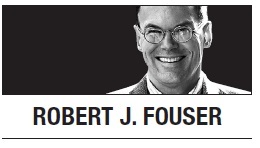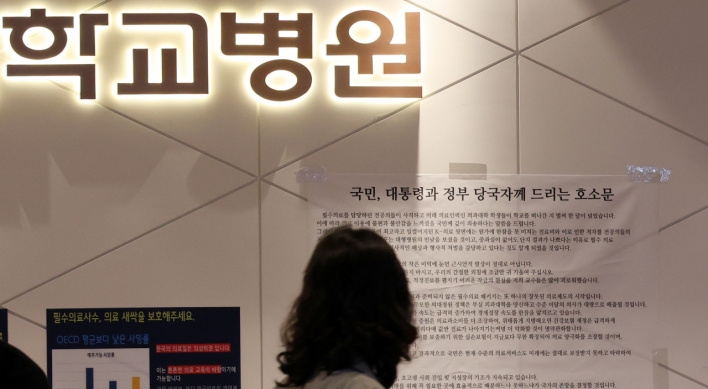[Robert Fouser] Hypertourism in Kyoto and beyond
By Robert J. FouserPublished : May 9, 2017 - 17:52
 Last week, people in Korea and Japan enjoyed a series of holidays and major tourist sites were crowded. The holidays overlapped with my visit to Kyoto, so I could experience the effects of hypertourism first hand. I lived in Kyoto for seven years at various points during the 1990s and 2000s and spent most of my time at secondary sites off the beaten path. Kyoto is a city of 1.46 million people so it is big enough to get lost in.
Last week, people in Korea and Japan enjoyed a series of holidays and major tourist sites were crowded. The holidays overlapped with my visit to Kyoto, so I could experience the effects of hypertourism first hand. I lived in Kyoto for seven years at various points during the 1990s and 2000s and spent most of my time at secondary sites off the beaten path. Kyoto is a city of 1.46 million people so it is big enough to get lost in.
The full extent of the tourist impact hit during transit and during searches with Japanese friends for a place to eat in the center of town in the evening. During the mid-2000s when I last lived in Kyoto, I remember crowds during peak tourist seasons, but nothing like what I experienced this year. The annual number of foreign tourists in Japan in the mid-2000s was around 6 million, but it has since soared to 24 million in 2016. As in Korea, most of the growth has come from a sharp increase in the number of Chinese tourists, but tourists from other countries have also increased.
The boom in foreign tourists has also affected other cities in Japan. Many foreign tourists stay in Osaka, mixing visits to historic sites in Kyoto and Nara with shopping in Osaka. According to friends, tourist sites in Tokyo are crowded with foreign tourists. The city will host the 2020 Olympic Games and is busy preparing for further increases in foreign visitors.
What has caused the sudden boom in foreign tourism in Japan? Three things that are not necessarily connected have driven the surge in recent years: Chinese tourists, a lower yen, and government policy. Sustained growth in the Chinese economy has created a middle class that afford foreign travel. Nearby countries are cheaper and easier to visit than Europe or North America, making places like Korea and Japan attractive destinations. With a huge population and continued economic growth, the pool of potential tourists from China will only continue to grow.
Beginning in 2012, Prime Minister Shinzo Abe pushed a package of reforms to stimulate the economy. These included lowering the value of the yen to help make Japanese exports more competitive. From 2008 to 2012 the yen was very high, which made travel in Japan prohibitively expensive for many tourists. The yen went down in 2012 after Abe took office and has stayed in a narrow range since. This made visiting Japan more affordable just as middle class Chinese were beginning to travel overseas.
Government policy also helped. As part of his economic reforms, Abe pushed for more foreign tourism as a way to make up for slumping domestic demand. One of the major reasons for the extended economic slump was declining domestic demand. An aging population and grinding deflation made it difficult to stimulate domestic demand. Bringing in foreign tourists helps stimulate demand quickly. The government has also relaxed restrictions on accommodations for tourists, which has helped services such as Airbnb thrive, thus driving down the cost.
Finally, there has been a change in attitude toward foreign tourists, particularly those from Asia. For years, foreign tourists were perceived as a minor concern. Signs and information in English and other foreign languages were developed as part of the vague notion of “internationalization” rather than being linked toward helping large numbers of foreign tourists.
During the 1990s and early 2000s, many Japanese held out the hope that the economy would return to the glory days of the 1980s. By the mid-2000s, it became clear that Japan needed to find new sources of economic growth. Instead of viewing foreign tourists as a nuisance with little economic benefit, they became viewed as valued customers. Tourist sites and shops now have signs in foreign languages and many have employees who speak foreign languages.
The difficulty of finding a quiet place for dinner in central Kyoto is a problem of success. After all, restaurants and bars with too few customers close. Many Kyotoites no doubt find it easier to hide or go out of town during Golden Week, but they take comfort in knowing that the flood of tourists, foreign and domestic, helps their city remain vibrant in difficult times.
The question for Kyoto is at what point do the negative effects of hypertourism on the residents outweigh the economic benefits. At that point, what can be done to minimize the impact without hurting the local economy? These are difficult questions that Kyoto and other cities facing hypertourism will have to deal with soon.
By Robert J. Fouser
Robert J. Fouser, a former associate professor of Korean language education at Seoul National University, writes on Korea from Pawtucket, Rhode Island. He can be reached at robertjfouser@gmail.com. -- Ed.




![[Herald Interview] 'Amid aging population, Korea to invite more young professionals from overseas'](http://res.heraldm.com/phpwas/restmb_idxmake.php?idx=644&simg=/content/image/2024/04/24/20240424050844_0.jpg&u=20240424200058)














